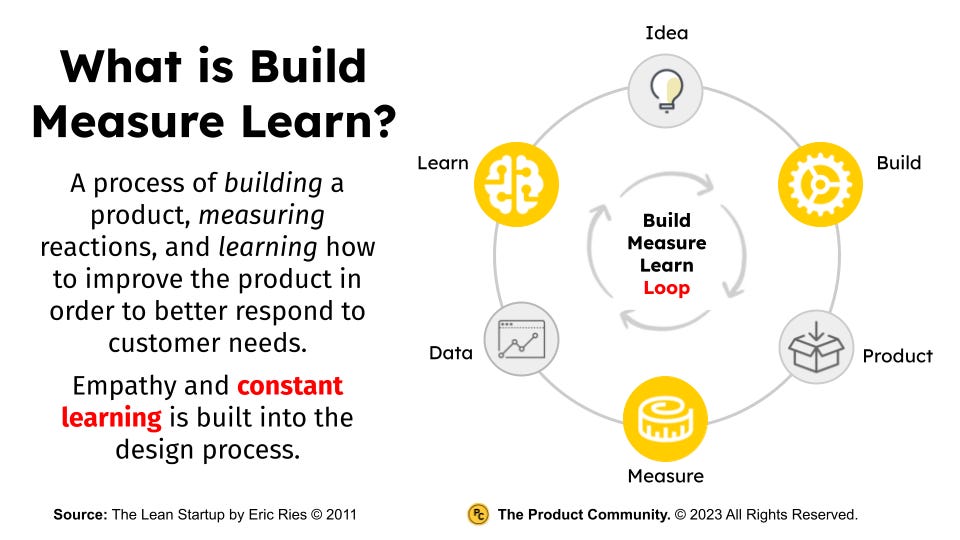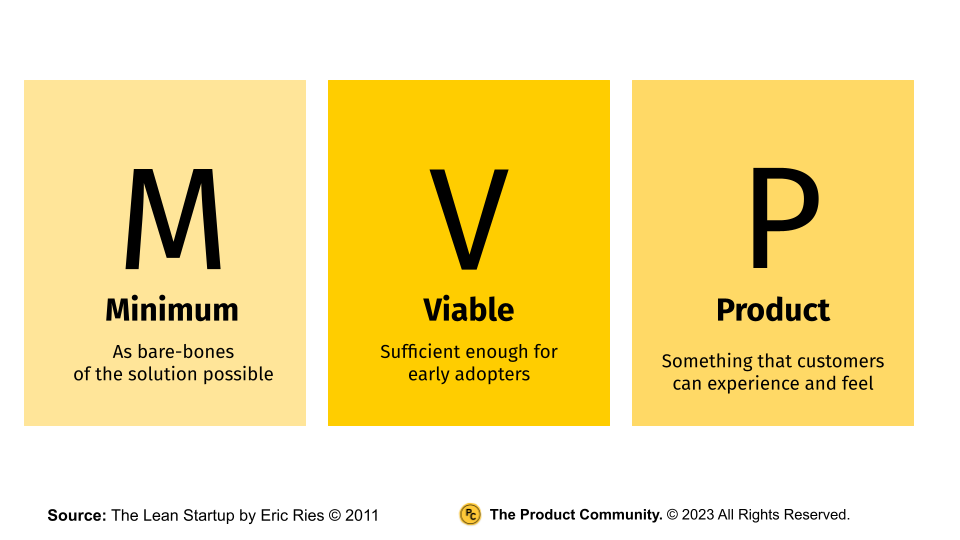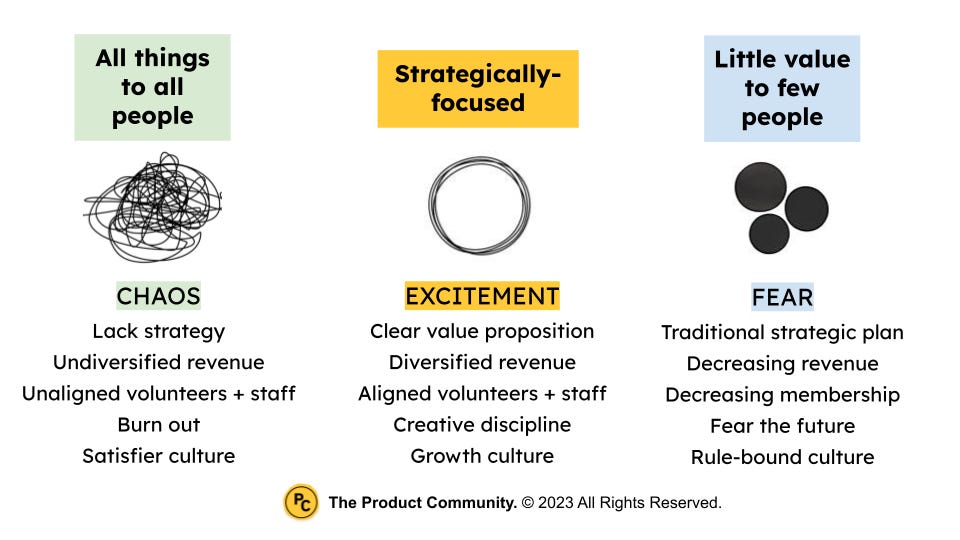Rapid Product Development
A Practical Guide to Rapid Prototyping for Associations and Nonprofits
Summary
Associations create value for their members.
We create value to entice new members to join, to help current members solve problems, and to guide members on their professional development journeys. We create value to demonstrate our worth and to grow: in reach, in revenue, and in strength of culture.
We are in the value creation business.
This article describes how to create new products for your association using rapid prototyping. In doing so, I cover the build | measure | learn feedback loop, define and provide an example for creating a minimum viable product (MVP), and apply these concepts to rapid prototyping.
Rapid prototyping is not a quick fix; it is an investment in continuous improvement and a commitment to innovation. Better yet, it’s a choice to deepen connection with our most fervent members (who will most likely widen our community by telling their friends!).
Rapid prototyping is a commitment to growth. Over time, a multiplier effect creates concentric circles for engagement, membership, and revenue.
The product community® is a product development learning community designed specifically for associations.
Associations Create Products Differently
“It is much easier to put existing resources to better use, than to develop resources where they do not exist.”
George Soros
As I’ve written many times in this newsletter, associations are unique. We are membership-centered, volunteer-led, and rooted in shared purpose. We create products for member consumption. We are deep into value creation, fostered by an ongoing dialogue with our communities.
Though we tend to be tactical and practical – preparing for the next event, publication, webinar, or course – the concept of value creation conjures connection (with members, across boundaries, and with new opportunities). Though there are similarities, this is the sweet spot for associations, mostly distinguishing us from how companies create physical products (chairs, coffee cups, cars, etc.) or non-physical products (software, music, financial investments, etc.).
Mostly, however, associations are about the timeless value of community and the power of leverage. When we speak of leverage, we speak of evergreen content, foundational knowledge, or applied learning. When we speak of leverage, we speak of reuse, scaffolding, or extending value.
Ideally, we operate as robust communities of practice. In this way, using a simple framework – like build, measure, learn – we can deepen our focus and widen our reach. Over time, we can get better at building relationships and understanding our customers in order to create products that engage, enlighten, and help solve pressing problems.
The Build Measure Learn Feedback Loop
“Speed is absolutely key to creativity. The more time it takes to create something, the less likely you are to create something.”
Patrick Stump
The Build-Measure-Learn feedback loop is a method used to develop products or services iteratively, with a focus on continuous improvement based on real-world feedback. The process involves three main steps: Build, Measure, and Learn.
Build. In this initial phase, we create a prototype or minimum viable product (MVP) that represents our idea or concept. The emphasis is on developing the product quickly and efficiently, with only essential features.
Measure. Once the prototype is ready, it's time to release it to the target audience. During this phase, you collect data and gather feedback about how users interact with the product. Metrics and analytics are used to measure user behavior and identify strengths and weaknesses.
Learn. Based on the data and feedback gathered in the previous step, we analyze the results to draw meaningful conclusions. We learn from the successes and failures of the product and use this knowledge to make informed decisions about improvements and necessary changes.
The loop then continues as you take the lessons learned in the learn phase and apply them to the next iteration of the product, starting again from the build phase.
Here’s how it would work for an association.
Let's consider a professional association called Association for Technology Leaders (ATL), which aims to provide online learning resources for its members. They want to create a new learning platform to offer courses and workshops.
Build. The ATL team creates a basic version of the online learning platform with a limited selection of courses and a simple user interface. They focus on getting the platform up and running quickly.
Measure. They launch the platform to a select group of members and monitor user behavior. They track metrics such as the number of course enrollments, user engagement, and feedback through surveys.
Learn. After analyzing the data, ATL discovers that members are highly interested in specific technical courses related to programming languages and digital marketing. However, they also find that the user interface needs improvement as some users found it confusing.
With the insights gained from the measure phase, ATL decides to make the following changes:
Build more courses on popular topics based on member interests.
Redesign the user interface to make it more intuitive and user-friendly.
The loop continues:
Build. ATL implements the changes and updates the platform with additional courses and the improved user interface.
Measure. They launch the updated version to a larger audience and collect more data on user engagement and feedback.
Learn. This time, they find that the new courses are receiving positive feedback and have higher enrollment rates. The improved user interface has reduced confusion and increased overall user satisfaction.
The Build-Measure-Learn feedback loop keeps ATL in a continuous cycle of improvement, allowing them to cater to their members' needs effectively and provide a valuable learning experience. With each iteration, the platform becomes more refined and aligned with the preferences of its users.
Next, let’s drill down a little further into the concept of minimum viable products, known commonly in the world of product development as MVP.
What is an MVP?
“As you consider building your own minimum viable product, let this simple rule suffice: remove any feature, process, or effort that does not contribute directly to the learning you seek.”
Eric Ries
A Minimum Viable Product (MVP) is the most basic version of a product or service that contains only the essential features and functionalities required to address the core needs of its target audience. It is developed with the primary purpose of validating ideas, testing assumptions, and gathering feedback from users with minimal time and resources invested.
Pros of an MVP
Faster Market Validation. Building an MVP allows you to get your product out to the market quickly, enabling you to gauge user interest and demand sooner.
Cost-Efficient. By focusing only on essential features, you save development time and resources, reducing the overall cost of the initial product development.
Feedback-Driven Improvement. Early user feedback helps identify strengths, weaknesses, and areas for improvement, guiding further development efforts.
Reduced Risk. Since you're investing less in the initial version, there's a lower risk of failure, as you can pivot or make changes based on user feedback.
Early User Acquisition. Launching an MVP allows you to start building your user base from an early stage, potentially creating a loyal customer community.
Cons of an MVP
Limited Features. The MVP might lack some of the desired functionalities, which could deter certain users who expect a fully-featured product.
Possibility of Poor User Experience. If the MVP is not well-designed or too buggy, it may lead to a negative impression among early adopters.
Competitive Risks. Revealing your idea too early may invite competitors to enter the market with a similar product.
Resource Allocation. The focus on the MVP might take away resources from other aspects of the business.
Steps to Create an MVP for an Association
Example: Let's consider the fictitious association, Association for Marketing Professionals (AMP) aiming to provide resources, networking opportunities, and educational content to its members.
Step 1. Identify Core Objectives and Target Audience. Define the primary goals of the association (e.g., resource sharing, networking). Identify the target audience (e.g., marketing professionals, students).
Step 2. List Essential Features. Identify the key features needed to fulfill the core objectives. This might include a member directory, discussion forums, resource library, event calendar, and member profile management.
Step 3. Prioritize Features. Rank the identified features based on their importance and feasibility for the initial MVP.
Step 4. Design a Basic User Interface (UI). Create a simple and user-friendly interface focusing on the core features. Keep the design clean and intuitive.
Step 5. Develop the MVP. Build the MVP with the prioritized features and the basic UI. Aim to complete development within a reasonable timeframe.
Step 6. Test the MVP Internally. Thoroughly test the MVP within the association team to uncover any major issues or bugs.
Step 7. Launch the MVP to a Limited Audience. Release the MVP to a small group of selected marketing professionals within the association.
Step 8. Gather User Feedback. Encourage early users to provide feedback on their experience with the MVP. Utilize surveys, feedback forms, or direct communication.
Step 9. Analyze Feedback and Iterate. Analyze the feedback received and use it to identify improvements and new features for future iterations.
Step 10. Scale and Enhance. Based on the feedback and additional insights, work on enhancing the MVP, adding more features, and expanding the user base.
Step 11: Full Launch. Once the MVP has been refined and improved based on user feedback, launch the complete product to a wider audience.
By following these steps, the Association for Marketing Professionals can create a successful MVP that meets the core needs of its target audience and gradually evolves into a robust platform based on user feedback and validation.
What is a Rapid Prototype?
“Life is like a ten speed bicycle. Most of us have gears we never use.”
Charles M. Schulz
Similar to an MVP, rapid prototyping is a process used in product development to quickly create a preliminary version of a product. The main goal of rapid prototyping is to test and validate design concepts and functionalities before investing significant resources in full-scale production.
The process involves using various techniques and tools to build a scaled-down, functional model of the product.. These prototypes can be simple physical objects or digital simulations, depending on the nature of the project.
Key characteristics of rapid prototyping include:
Speed. The emphasis is on quickly creating prototypes to accelerate the development cycle and gather feedback early in the design process.
Iteration. Rapid prototyping allows for multiple iterations and refinements based on feedback and testing results, leading to continuous improvement of the design.
Cost-effectiveness. By identifying and resolving design issues early on, rapid prototyping can save time and resources that might otherwise be wasted on producing a flawed final product.
Flexibility. Different materials and methods can be employed to produce prototypes, providing flexibility to test different aspects of the product, such as aesthetics, functionality, and user experience.
Rapid prototyping is widely used in industries like product design, engineering, software development, and even architecture to create tangible representations of ideas and designs for evaluation and validation. It plays a crucial role in reducing development risks, validating assumptions, and ensuring that the end product meets user requirements and expectations.
How to Rapid Prototype
“The ability to simplify means to eliminate the unnecessary so that the necessary may speak.”
Hans Hofmann
Creating a rapid prototype for an association involves building a simplified version of the program to test its functionality and gather feedback quickly. Here are the steps to achieve this:
Define Your Goals. Clearly outline what you want the association program to achieve. Understand the main features and functionalities you want to include in the prototype.
Identify Core Requirements. Focus on the essential elements of the program. Avoid getting caught up in unnecessary details at this stage. Stick to the most critical functionalities.
Choose the Right Tools. Select tools and technologies that allow for rapid development. Frameworks and templates can save time and effort.
Create a Basic Design. Design the user interface (UI) of the program. Keep it simple but functional. You can use wireframes or mockups to visualize the layout and flow.
Start Building. Develop the prototype by implementing the core functionalities. Work in iterations, adding features step by step.
Testing. Regularly test your prototype to ensure each feature works as intended. Focus on user experience and remove any obstacles that may hinder smooth navigation.
Gather Feedback. Once you have a basic working prototype, share it with a small group of potential users or stakeholders. Collect their feedback and insights.
Iterate and Refine: Based on the feedback, make necessary changes and improvements. Iterate on the prototype, adding more features or refining existing ones.
Keep It Simple. Remember, the goal of a rapid prototype is not to build a final product but to validate ideas and gather feedback. Avoid complexity that may slow down development.
Prioritize Speed Over Perfection. The prototype doesn't have to be flawless. Aim for a functional model that can be quickly modified based on feedback.
Engage Stakeholders. Involve relevant stakeholders throughout the process. Regularly communicate progress and updates to keep them engaged and informed.
Learn from the Process. Note down the challenges faced, lessons learned, and insights gained during the rapid prototyping. These will be invaluable for the next stages of development.
Refine and Expand. After several iterations and refinements, you'll have a more comprehensive prototype. Assess its success in meeting the defined goals.
Plan for Scaling. If the prototype proves successful, start thinking about the full-scale development. Use the lessons learned from the prototype phase to create a more robust and complete program.
By following these steps and keeping the iterative nature of rapid prototyping in mind, you can efficiently build a functional association program that addresses the core needs and expectations of your members. Remember to stay flexible and open to changes throughout the process, as the feedback you receive may lead to valuable insights and improvements.
Implications for Associations
"The essence of strategy is choosing what not to do."
Michael E. Porter
Fast isn’t always better, but focused action almost always is.
By focus, we mean making choices about what to do and not to do. By focus, we mean choosing the best, most compelling ideas and seeing them through. By focus, we mean building exciting value propositions and corresponding products. By focus, we mean strengthening relationships with our members.
If we believe that re-energizing our communities is key to revenue, then investing in value creation, product development, and rapid prototyping is the new key to the highway.
Rapid prototyping – though considered fast – is not a quick fix. It is a commitment to engaging your members in value conversations so we can (together) build better products to kickstart, grow, and deepen community.
It’s also a way to be strategically-focused as opposed to all things to all people or running an operation that is of little value to few people.
Just remember, product-led growth fuels connection. Join the product community and flip your destiny.
About the Author
James Young is founder and chief learning officer of the product community®. Jim is an engaging trainer and leading thinker in the worlds of associations, learning communities, and product development. Prior to starting the product community®, Jim served as Chief Learning Officer at both the American College of Chest Physicians and the Society of College and University Planning.
Please contact me for a conversation: james@productcommunity.us.






